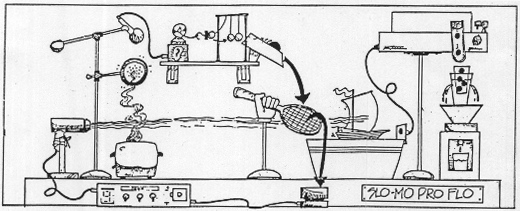Hallmarks of Jesuit physics, the annual Rube Goldberg projects are known for their difficulty but also their rewarding nature. Although they are certain to come with some frustration and head-scratching, these machines are ultimately rewarding, as students get to see a tiny marble set off a myriad of other processes, all on a contraption that they built themselves, culminating in a flag raise and wave.
After hours of hard work and a few delays as a result of snow days, the projects were tested and evaluated by teachers on February 12th and 13th. Hopeful students came forward and demonstrated their projects, each student starting off with the drop of a marble and stepping back to let the machine run for approximately a minute.
Unlike in other years, students had to be flexible and deal with the weather. Originally scheduled to be due on the 10th, the projects were pushed back by inclement weather days on the February 7th and 11th. Additionally, students had a shorter time than in past years. Mr. Timothy J. Howard ’08, a physics teacher at Jesuit, remarked that “this year was a lot faster than last year. They did not have as much time to work on it, but they worked well with the deadline.” Although apparently more challenging, the limited time still yielded excellent projects.

Despite being a fun project overall, these Rube Goldberg machines were also a source of a good deal of exasperation.
Some struggled with getting started on their project and staying on track. Chris Artigues ’15 spoke of these challenges, explaining, “It’s frustrating. We did not follow our blueprint at all, and it was pretty hectic. We were just going one step after another and didn’t have the final thing in mind.”
Michael Shropshire ’15 had similar troubles with the blueprints, saying, “My blueprint was really bad. I tried to use the stuff in my blueprint, and it did not work.” Additionally, he said that you have to be prepared for “the amount of failure you have.”
Others had difficulty with finishing their projects. Although he and his group started off strong with little difficulty, Dan Carver ’15 unexpectedly experienced a broken part towards the end. Carver stated that “It was disappointing when replacing something didn’t work and really frustrating. It was also really stressful since we had a short amount of time.”
When completing these projects, time was always a factor. Completing things as efficiently as possible could ultimately decide the success of the project. Robert Africa ’15 emphasized this as well, explaining that “time is of essence” by saying, “I recommend working any free periods or after school. Time is the most valuable thing.”
Furthermore, the ability to move on and surpass obstacles is a valuable trait with these projects. Artigues continued that sometimes “you’ve just gotta look forward and think about how tomorrow is gonna be a better day.”
Even with these struggles, the projects were a lot of fun for the majority. Without as much structure as some other assignments, students were able to be creative. Shropshire commented on this and said, “I like that I can be creative and think outside the box. You’re free to do what you want. There aren’t really any instructions, you just have to complete a task in any way you can.”
Dominic Iannelli ’15 commented, “I think the project is a nice break from the note-taking, homework, and test routine. We get a much more hands-on experience where we can apply what we learned in the classroom.” Also, he said that “seeing the machine actually work for the first time is a great feeling.”
Because it is so unlike most other school projects, it meant immersing many students into a foreign world of construction. Mr. Howard said, “I like seeing the use of the power tools because some students don’t really know how to at first…On top of that, [I liked] seeing their plans develop and, as they encountered road bumps on the way, seeing them make adjustments and change things.” He also marveled at the originality of some of their designs, noting “their final results are really cool. The unique ideas they come up with are awesome.”
Because of its perennial nature, the project has been something that students looked forward to. Artigues said “I’ve been looking forward to it from previous years. It seemed pretty interesting when we got to see how the machines worked.” He also agreed that his “favorite thing was putting it all together and seeing the end result.”
With their projects now behind them, the triumphant juniors had some words of wisdom for those who will complete the project in coming years. Shropshire advised, “make parts at home and bring them in.” Arigues suggested, “make a plan and stick with it. Make a good plan. It’s easier to have a structure.” Although these students may have done things a little differently the second time around, Mr. Howard commended their work, saying, “I think it went really well. There were some really great machines that we got out of it.”
[jwplayer mediaid=”70536″]






